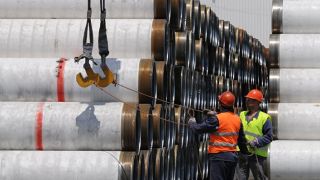Iran has revealed details of the gas agreement with Russia. The oil minister said that Gazprom will build a gas pipeline through the whole of Iran, and supplies will amount to the capacity of two "Northern Streams". Thus, Russian gas will be supplied to both Iran and neighboring countries. Experts believe that these are overambitious plans, unless the minister has made a reservation.
"The implementation of this 30-year-old agreement, which can be called the pinnacle of regional diplomacy by Shahid Raisi (the deceased president. — Ed. note), in addition to eliminating internal imbalances, will turn Iran into a hub for gas supplies to the region and will lead to a significant increase in trade and exchanges, as well as the economic and political security of the country," Oil Minister Javad Oudji said at a government meeting, IRNA news agency reports.
According to the head of the Iranian Oil Ministry, Gazprom will build a gas pipeline across the country from north to south, and supplies will amount to 300 million cubic meters per day, which is equivalent to the capacity of two "Northern Streams". However, these figures are only in the Iranian version of the article.
"Currently, the total production of low-sulfur gas in the country is about 850 million cubic meters per day. The project will allow you to import from Russia has 300 million cubic meters of gas per day, and Russia, which has technologies in the field of pipeline construction along the seabed, has also assumed the costs of building this pipeline," Javad Oudji said.
He estimates the project's turnover at $ 10-12 billion and said that over the past month, the National Iranian Gas Company and Gazprom have signed several documents.
"On the sidelines of the weekly government meeting, the minister told reporters that less than a month ago between Iran and Russia has signed some documents according to which part of the Russian gas will be transferred to Iran for consumption, and part for export and ensuring the energy security of neighboring countries," the Shana news agency already writes.
Gazprom itself announced in June that it had signed a Strategic memorandum on working out the organization of Russian gas supplies to Iran.
Next to Iran is Pakistan, which has pledged to complete the gas pipeline to Iran, and Oman, which counted on gas supplies through the Persian Gulf for its LNG terminal. In addition, India is located through Pakistan, and Gazprom has also studied the possibility of building LNG terminals in Iran.
Due to sanctions and counter-sanctions, Gazprom's exports to Europe have decreased almost fivefold — from 150 billion cubic meters to less than 30 billion cubic meters per year. At the same time The EU wants to completely abandon Russian gas in 2027, when new LNG plants in the United States and Qatar. And Gazprom needs to reorient supplies. So far, as stated, the option of "Power of Siberia — 2" with a capacity of 50 billion cubic meters to China and gas supply to Central Asia is being considered. In Uzbekistan, volumes of 11 billion cubic meters were called.
If the Iranian minister was not mistaken, then, according to Maxim Khudalov, chief strategist of the Vector X investment company, these are overambitious plans.
"Moreover, in the Caspian Sea, we and Azerbaijan have small pipelayers who are unlikely to be able to pull a large—diameter pipe," the expert says.
Maxim Khudalov also notes that the construction of such a pipeline will take at least 5 years, and its costs will exceed $ 40 billion: "So far it seems that this is a very distant prospect and we will not even see the project until 2026."
Earlier, Deputy Prime Minister Alexander Novak said that the initial gas supplies to Iran and through the country were estimated at 10 billion cubic meters. And in July, Ashgabat and Tehran agreed on swap supplies to Iraq has 10 billion cubic meters per year and the expansion of the gas pipeline to a capacity of 40 billion cubic meters. Experts believed that the development of the gas transportation infrastructure between the two countries may be related to the supply of Russian gas.
"It is obvious that cooperation with Iran in the gas sector is currently being actively discussed, and Iran's neighbors in Southeast Asia have a huge energy shortage and, accordingly, a huge potential for importing pipeline gas. Strategic agreements between Moscow and Tehran open up opportunities for commercial negotiations with potential buyers. They will ultimately determine the scope of the project and investments," said Alexey Grivach, Deputy Director of the National Energy Security Fund (NSF).

 Zurab Tsereteli died in Moscow
Zurab Tsereteli died in Moscow A US soldier convicted in Vladivostok went to prison because of dirty dishes
A US soldier convicted in Vladivostok went to prison because of dirty dishes He had no cards: in Ukraine they make fun of the death of Pope Francis
He had no cards: in Ukraine they make fun of the death of Pope Francis Russian oil was recalculated at the real exchange rate
Russian oil was recalculated at the real exchange rate The New York Post: There are six candidates for the place of the Pope
The New York Post: There are six candidates for the place of the Pope The European business that left the Russian Federation was surprised by the prosperity of Asian giants in the country
The European business that left the Russian Federation was surprised by the prosperity of Asian giants in the country